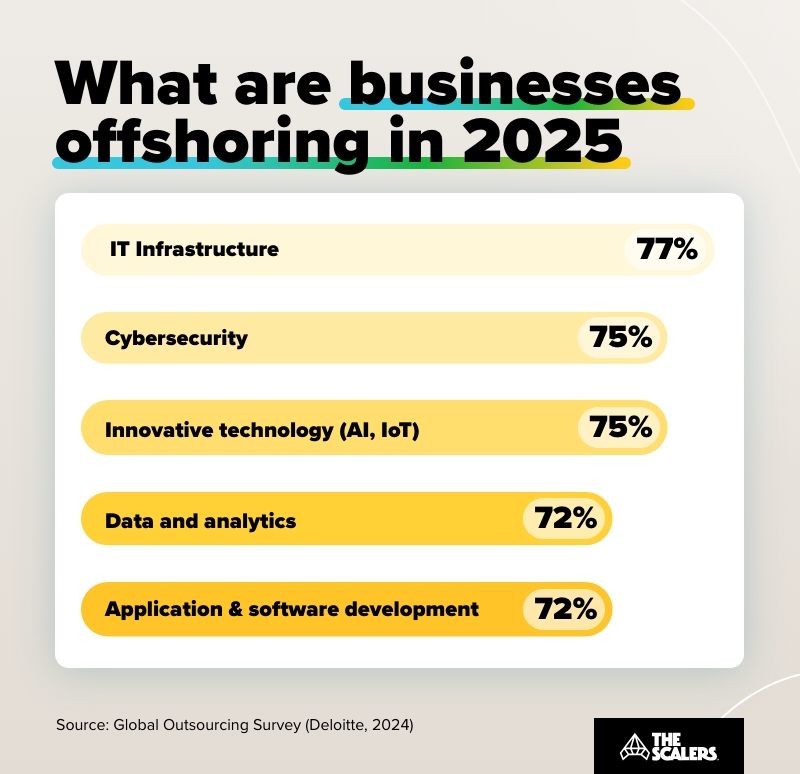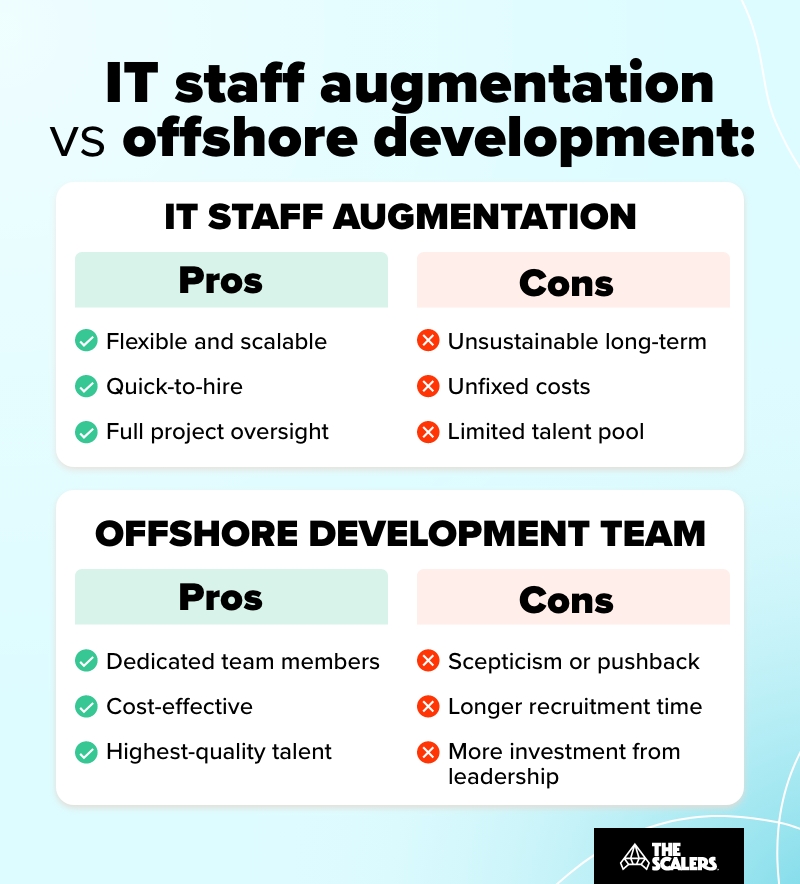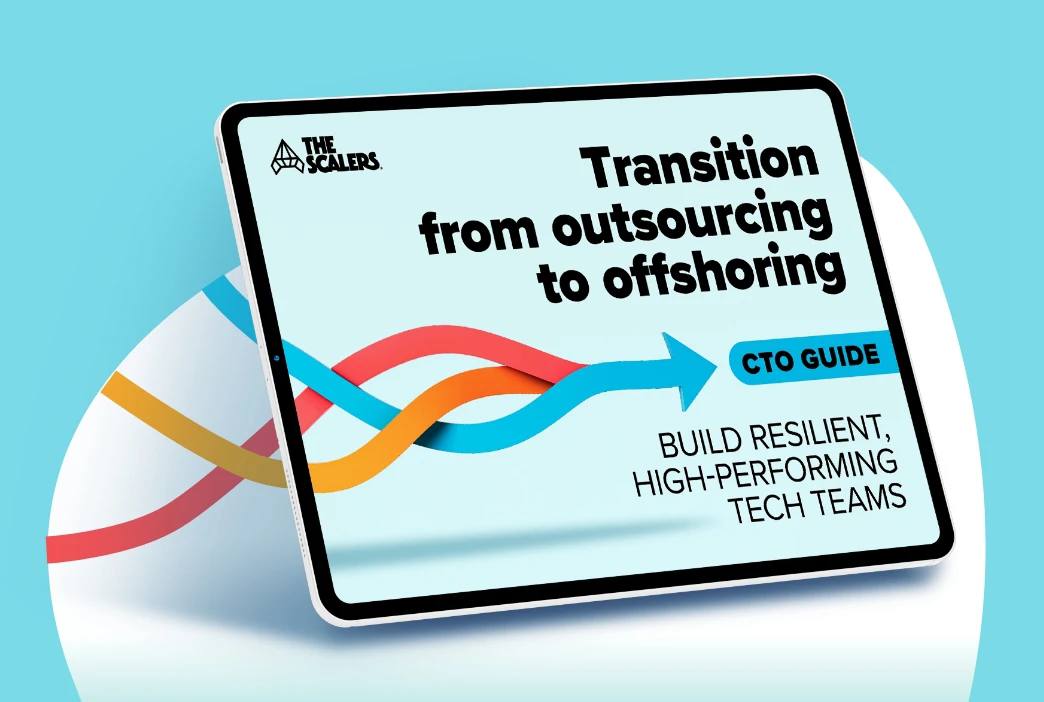Global teams are on the rise.
While not a new concept, hiring tech talent abroad has been gaining traction over the past decade as IT leaders struggle to secure the specialised profiles they need to stay ahead, especially in high-growth areas like web development, data and AI, and cloud.
If you’re a CTO looking to enhance your local engineering capacity with global talent, there’s a number of different team extension models to consider.
In this article, we’ll compare two of the most popular, IT staff augmentation and offshore development, to help you optimise your tech team.
What is IT staff augmentation and when to use it?
Offshore IT staff augmentation is a flexible model where businesses work with an external vendor to quickly hire contracted talent, typically for short-term work. After assessing project needs, companies can bring on additional engineers to complete projects on time and overcome skills gaps, which in 2025 are affecting 75% of IT employers according to ManpowerGroup.

Let’s assume you’re the CTO of a successful company specialising in building state-of-the-art home security systems. Because of a series of break-ins in your city, there’s been a sudden spike in demand for your products and services. You need to increase your development capacity, and fast. In this scenario, hiring a few more developers on a short-term contract until this demand surge levels out is the best solution.
Or, you might have a stellar local development team that’s more than capable of delivering software within deadlines. But then you take on a project that requires specific skills that your existing team lacks, such as advanced data analytics. Instead of spending time and resources hiring someone new, IT staff augmentation allows you to plug the appropriate profile into your existing set-up quickly and easily, and cycle this team member out when the project is complete.
What is an offshore development team and when is it the best choice?
Finding team members that really know the ins and outs of your business and are aligned with your culture can be challenging with the more project-centric IT staff augmentation model.
That’s where an offshore software development team comes in.
Also known as a dedicated development team, this model involves hiring professionals abroad who are full-time, permanent employees and act as a value-adding extension of your local office.
Building an offshore development team is the right choice when you’re looking to hire talent for the mid-to-long-term, and if you want to headhunt specific profiles.

There are a few different approaches to take based on your talent requirements, long-term growth plans, and resources. For larger multinationals that are looking to hire 100+ people off-the-bat, it’s often preferable to set up an offshore subsidiary and dedicated office. Small-to-mid size businesses that want to start out with hiring fewer engineers typically work with an offshore software development services company who acts as an Employer of Record abroad and handles recruitment, sets engineers up with a place to work, and handles all other logistics on the ground.
IT staff augmentation vs offshore development team: What’s the right option?
There’s no one-size-fits-all answer here and choosing the right model really depends on the projected scope of both the work and employment contract.
Let’s look at some of the main pros and cons of each model.

Advantages of staff augmentation
- Flexible and scalable: Businesses can hire employees on a flexible, contract basis, and teams can easily be scaled up or down as needed.
- Quick-to-hire: Hiring can take as little as a few days, depending on the vendor’s talent network, keeping workflows on track and allowing businesses to efficiently meet sudden spikes in demand.
- Full project oversight: Because developers are part of your in-house team, you have full control over project delivery and workflows, which is not always the case with other team extension models, such as IT outsourcing.
Potential challenges of IT staff augmentation
- Unsustainable long-term: The people you hire typically work in a task- or project-based capacity, meaning that they may not always be engaged with your company’s long-term vision nor feel a lot of ownership over projects.
- Unfixed costs: IT staff augmentation is typically billed on a time-and-materials pricing model, where you pay for time spent and resources used. Sometimes, it can be hard to budget the final cost of a hire, and other unexpected costs may pop up during a project.
- Limited talent pool: The talent you have to choose from is typically based on who the vendor can find as quickly as possible, which limits the potential profiles you can connect with, especially for highly specialised roles.
Advantages of offshore software development
- Dedicated team members: Developers are regular full-time employees, engaged with your company’s mission and goals, taking ownership, and contributing long-term value.
- Cost-effective: Hiring an offshore development team is typically more cost-effective than hiring the same full-time developers at home. Popular offshore destinations like India, Eastern Europe, and Latin America are go-to locations for US, UK, and Western European companies looking for top talent while keeping overheads low.
- Highest-quality talent: Offshore development often gives you more room to headhunt the engineers you’re after and access top profiles, many of whom want to work on high-impact roadmaps and not short-term external projects.
Potential challenges of offshore software development
- Local scepticism or pushback: Existing team members may be sceptical of, or resistant to, bringing on offshore developers, as this can be perceived as a threat to their job security, sometimes requiring leaders to do a bit of extra work to get local teams on board with going offshore.
- Longer recruitment process: This model typically follows a similar recruitment timeline to local hiring, with talent sourcing, skills tests and interviews, and notice periods extending the process to 1-3 months. This can be a challenge for companies that need talent immediately.
- More investment from leadership: Team leaders will need to spend more time upfront properly onboarding and integrating offshore team members, and may need to adjust workflows and meeting times slightly to make sure there is enough overlap and communication between home and offshore teams.
The Scalers has given us a sense of belonging, moving from their IT hub to our own building. They help us with each and everything we do; HR, technology, admin, everywhere. I’ve never seen anyone else provide this in the industry.
IT staff augmentation vs offshore development: the bottom line
If you’re looking to expand your engineering capacity abroad, understanding the ideal use cases for each model, and weighing their advantages and challenges, can help avoid ineffective (and expensive) hiring mistakes out of the gate.
Key takeaways:
-
1
Tech companies around the world aren’t able to secure the top talent they need, leading businesses to embrace various team extension models for global collaboration.
-
2
IT staff augmentation is beneficial for meeting sudden demand, accessing skills for specific projects, and gaining a competitive edge in the market.
-
3
IT staff augmentation is not a sustainable long-term solution due to potential lack of ownership and investment from talent, and an unfixed pricing model.
-
4
Offshore software development is a long-term approach, which involves setting up a dedicated team of full-time, permanent engineers abroad.
-
5
Hiring with a dedicated offshore development model takes longer than an IT staff augmentation model, and may require a greater investment of time from tech leaders upfront.
If you’d like to know more about either of these models, just fill out this contact form and one of our senior advisory executives will be in touch.
FAQs
IT staff augmentation involves hiring contracted workers for short-term projects or to temporarily fill talent gaps, while setting up an offshore software development team means recruiting full-time, permanent employees abroad who are an in-house extension of your local team.
IT staff augmentation typically works on a time-and-materials model, where you pay for time spent and resources used without locking in a rigid scope. Costs associated with offshore development vary based on whether you are setting up your own offshore subsidiary or collaborating with an offshore services provider who acts as an Employer of Record. For the latter, the provider typically charges companies a flat rate that covers developer salaries, benefits, office space, hardware, and other associated costs.
This will depend on the projected scope of your team as well as the profiles you are looking for. Generally, for short-term projects, IT staff augmentation will be the more cost-effective model, while for long-term teams, offshore software development is more budget friendly
IT staff augmentation typically gives you access to a smaller pool of talent and contracted engineers may be less engaged with your company, completing their tasks and moving on. Offshore software development has a longer recruitment time than IT staff augmentation, and team leaders will very often need to do more work up-front to properly set the offshore and home teams up for a successful collaboration
Build Your Team,
Not Just a Contract
With The Scalers’ offshore dedicated development team, you get engineers who join your workflow for the long run. Grow steadily, stay flexible, and work with people who care about the product as much as you do.








